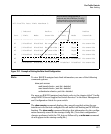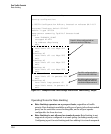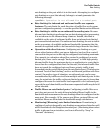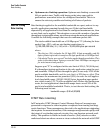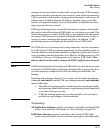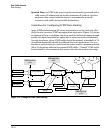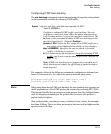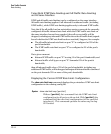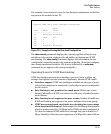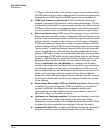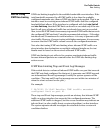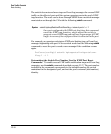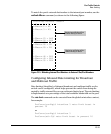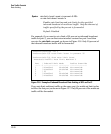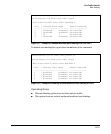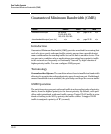
Port Traffic Controls
Rate-Limiting
For example, if you wanted to view the rate-limiting configuration on the first
six ports in the module in slot “B”:
ProCurve(config)# show rate-limit icmp b1-b6
Inbound ICMP Rate Limit Maximum Percentage
| Rate
Port | Mode Limit
----- + -------- --------
B1 | Disabled Disabled
B2 | kbps 100
B3 | % 5
B4 | % 1
B5 | % 1
B6 | Disabled Disabled
Figure 13-4. Example of Listing the Rate-Limit Configuration
The show running command displays the currently applied setting for any
interfaces in the switch configured for all traffic rate-limiting and ICMP
rate-limiting. The show config command displays this information for the
configuration currently stored in the startup-config file. (Note that configura-
tion changes performed with the CLI, but not followed by a write mem
command do not appear in the startup-config file.)
Operating Notes for ICMP Rate-Limiting
ICMP rate-limiting operates on an interface (per-port) basis to allow, on
average, the highest expected amount of legitimate, inbound ICMP traffic.
■ Interface support: ICMP rate-limiting is available on all types of ports
(other than trunk ports or mesh ports), and at all port speeds configurable
for the switch.
■ Rate-limiting is not permitted on mesh ports: Either type of rate-
limiting (all traffic or ICMP) can reduce the efficiency of paths through a
mesh domain.
■ Rate-limiting is not supported on port trunks: Neither all-traffic nor
ICMP rate-limiting are supported on ports configured in a trunk group.
■ ICMP percentage-based rate-limits are calculated as a percentage
of the negotiated link speed: For example, if a 100 Mbps port negotiates
a link to another switch at 100 Mbps and is ICMP rate-limit configured at
5%, then the inbound ICMP traffic flow through that port is limited to 5
Mbps. Similarly, if the same port negotiates a 10 Mbps link, then it allows
13-15



